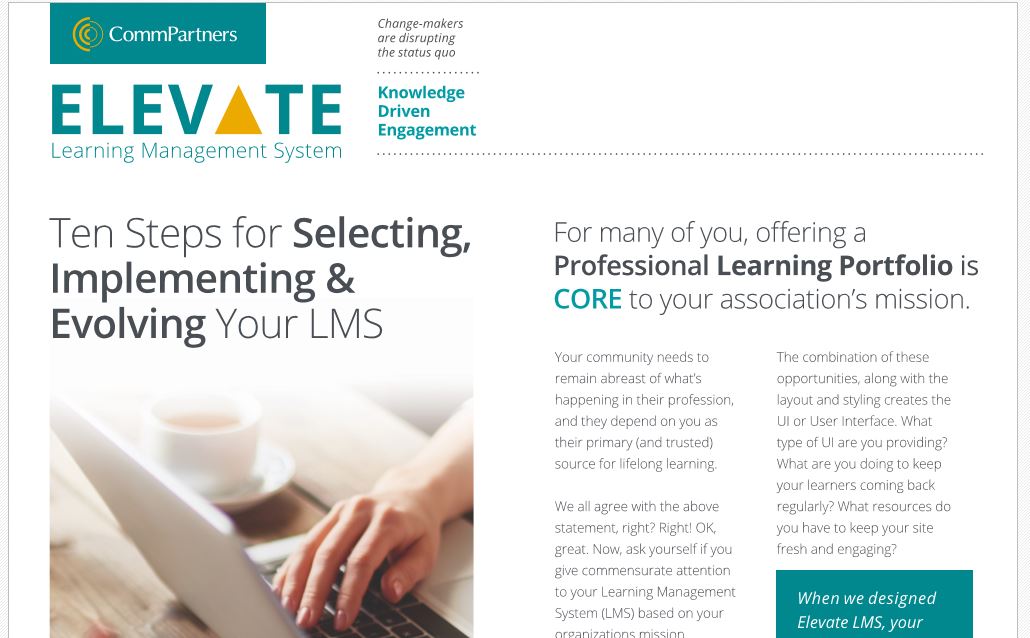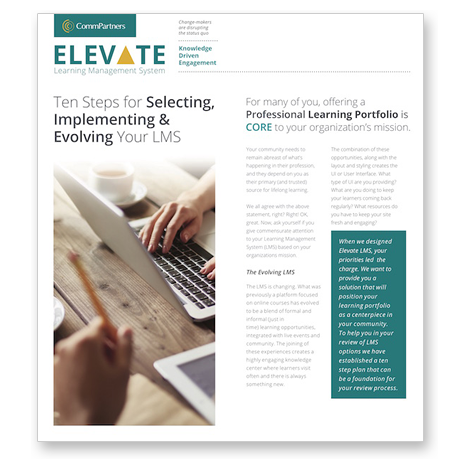
by Aubrey Mellos | Sep 6, 2017 | Blog
By Mary Byers, CAE, CSP
I’m intrigued by the associations who are doing big things. It may be something internally to secure the health of the organization itself, something on behalf of members, or something for the greater good of the world. If you’re interested in making a leap on behalf of your organization, here’s how to do it:
Identify the leap. Mark Tomlinson, a retired association CEO, helped engineer four inter-related leaps on behalf of his former organization. Naming the leaps was the first step. Mark’s leaps were: redefining the community the association served, additional revenue, enhance product/service delivery mechanism and divestiture of capital assets. If you name it, you’re more likely to claim it.
Engage in a 90-day sprint. In short, a sprint requires you to set aside work so that you can focus on the most important work. I’ve written in depth about how to do this here. In all my years as a consultant, this is one of the most powerful concepts I’ve come across.
Aim for excellence. Jim Collins, author of Good to Great: Why Some Companies Make the Leap and Others Don’t, says, “Good is the enemy of great. And that is one of the key reasons why we have so little that becomes great.” Set your sights high and don’t settle. Members are attracted to excellence.
Recalibrate as necessary. The quest for excellence often is mistaken as the quest for perfection. Our desire to do things “right” often keeps us from trying and discourages continuous enhancement. Starting with the expectation that you WILL recalibrate makes it acceptable to do so (versus seeing recalibration as an admission of failure). I love this quote from author Robert Barult: “…taking a step backward after taking a step forward is not a disaster, it’s more like a cha-cha.” Come to the party ready to dance and you’ll succeed.
Declare your association an inertia-free zone from now on. It’s harder to leap when you have to gather the energy to do so. If your culture is one that supports, encourages and celebrates leaping (vs. protecting the status quo), you’ll see more people and teams getting the running start they need to leap. I like what Wharton Business School professor Rita Gunther McGrath says, “…allowing an existing structure to remain in place for too long creates inertia and results in and organization that is maladapted to the opportunities it finds.” Inertia is an innovation-killer so do whatever you can to discourage it.
Try a triple jump. Once you’ve got the momentum necessary to leap, keep going. Movement in one area often makes it easier to create movement in another. When one leap is complete, ask, “Where can we get leverage and momentum on behalf of the organization now?” Attempting a triple jump is a natural inertia-buster and increases the overall return on investment for your association.
Mary Byers, CAE, CSP, shares additional strategy starters for busy association professionals in her new online learning series titled, Momentum: Strategy Starters for Today’s Association Professional at leadwiselearning.com. She is also the author of Race for Relevance: 5 Radical Changes for Associations.

by Aubrey Mellos | Aug 22, 2017 | Blog
By Mary Byers, CAE, CSP
Meetings. Deadlines. The day-to-day work of running your organization. All of these get in the way of doing new work on behalf of your association. But new work is often necessary to create leverage and momentum—especially when you’re stuck in a business-as-usual environment. A 90-day sprint may be just what you need to get ahead. This time period is long enough to accomplish something big, but short enough to create a sense of urgency (one of the advantages of the sprint concept). Here’s how to use a 90-day sprint:
Clearly identify the purpose of your sprint. Are you setting aside time to develop a plan or implement one? Will you do a deep dive into a challenge such as declining revenue or meeting participation? Do you want to complete 90 days of research, either about your members or how other associations have done what you want to do? The more clearly you define your work, the more likely you will complete it.
The National Association of Healthcare Quality wanted to demonstrate that it was keeping up with evolving trends in healthcare quality by articulating evolving competencies for advanced and master practitioners. According to NAHQ CEO, Stephanie Mercado, CAE, “The quality space is crowded and being first to market is key, so our goal was to bring a quality product to market fast.”
Assemble your team. Though 90-day sprints can be done solo, the larger the project, the more likely you’ll need others’ help. If your project requires more than just you working on it, get buy-in from the people and departments you need before you begin so that you don’t lose time after the clock starts ticking.
Assign work. Identify who is going to do what. Be clear about the end goal so that your team is doing work that supports your goal. Productivity expert Peter Drucker says, “There is nothing so useless as doing with great efficiency that which should not be done at all.” I agree.
Create a feedback loop. Use an online productivity tool such as Basecamp, Asana or Teamwork Projects to share information and track progress all in one place. Use preset meetings to troubleshoot, review work and determine next steps.
Set aside any non-necessary work and put your head down. It’s hard to ignore incoming e-mails and calls (but easier to do if you turn off e-mail notifications and silence your phone) but a powerful way to boost productivity. (My personal e-mail notification has been turned off since 2011, though I check it several times a day.) Work in blocks to allow you to concentrate and avoid the time loss of task switching. Start your day with work related to your sprint and only check your e-mail once or twice a day during your sprint. This is counter to how America works but essential to making gains and achieving big things.
Take stock. Where are you at the end of 90 days? Is there still work to be done? What’s next? All of these are valuable questions when you reach the end of your sprint. The answers will help determine your next steps.
NAHQ launched one competency area every 90 days, for 6 cycles. When the association reached the last topic, it republished the previous 5 competencies and the final competency into one book called HQ Essentials. According to Mercado, “We sent the book to all members for free as part of a larger strategy to improve our value proposition. Members immediately put it to work, developing models for staff structure, competency based job descriptions, etc. The result for NAHQ was demonstrated relevance for our members and the ability for NAHQ to use the HQ Essentials as a product development framework for the future.”
Celebrate. Be sure to take time to celebrate when your sprint is over. Doing so will make it more likely that you’ll be willing to do another…after you take a needed break, of course!
Mary Byers, CAE, CSP, shares additional strategy starters for busy association professionals in her new online learning series titled, Momentum: Strategy Starters for Today’s Association Professional at leadwiselearning.com. She is also the author of Race for Relevance: 5 Radical Changes for Associations.

by Aubrey Mellos | Jun 22, 2017 | Blog
FREE WEBINAR
Podcasts: Jumping Headfirst Without Fear
July 6th 1-2pm EDT
REGISTER NOW
Guest post by Doug Sandler
Think about today’s society. When people want it, they want it now. Media on-demand is hot and now more than ever it makes sense to capitalize on audio on-demand. A sharp segment of the audio on demand market is turning to podcasting to get their message out. 67 million people tune into podcasts every month* and if you are a fan of podcasts, you understand why. As a listener, you get to select your podcasts with pinpoint accuracy, the subject matter, format and style you like best. Plus, you get to choose when you listen. Your commute can turn your car into your university on wheels, or your kitchen can become your classroom while you are cooking dinner. No matter where you are, your podcasts can follow you.
Podcasting for your Association
So why should you care? As an association, this means a podcast can be utilized multi-fold. First, it can be used to provide educational content to your membership, from right within your learning management system (LMS). Spread your knowledge to your members and share best practices, industry updates and the latest news specific to your association. Additionally, podcasting is a way to reach a segment of your association that may not have the resources to make it to association gatherings. Many organizations do not have the budget to send all of their staff to conferences. With podcasting, through live recorded conference interviews, you have an opportunity to share conference content and bonus material, further engaging your membership. Furthermore, it is a great platform to diversify your learning portfolio.
Additionally, with podcasting you have an opportunity to create non-dues revenue through podcast sponsorship. Vendors and partners that regularly work with your association are looking for creative ways to reach your membership and podcasting is a premium place to meet your members and share their message. Any fees associated with podcast production can easily be offset by podcast sponsorship.
How to Get Started
Regarding production, getting set up to start a podcast is less complicated than you may think. Typically, entry to this space would consist of purchasing a high quality studio microphone, recording software and source to host your show. Like most associations, however, you might be short handed to handle the technical aspects of the show. There are many production companies for hire to handle all of the technical components of your show. The best advice would be to talk to a full-service production company so your association can develop a strategy for not only producing and editing your show, but to help you best develop a marketing plan to get your show launched and out to your membership. “Done with you” or “done for you” versions of production are available and should be investigated to get your show off and running properly.
One thing is certain, podcasting is on its way up. Now is the time to set the fear aside, get wet, and take advantage of podcasting to reach a greater percentage of your membership and develop an additional revenue stream. You will be extremely satisfied with your results.
 Doug Sandler is founder of TurnKeyPodcast.com, a full service podcast production company. He is also host of The Nice Guys on Business podcast, the #1 ranked business show on Overcast and was awarded iTunes coveted New and Noteworthy ranking when launched in 2015. His interview format show is heard in 165 countries and downloaded over 100,000 times every month.
Doug Sandler is founder of TurnKeyPodcast.com, a full service podcast production company. He is also host of The Nice Guys on Business podcast, the #1 ranked business show on Overcast and was awarded iTunes coveted New and Noteworthy ranking when launched in 2015. His interview format show is heard in 165 countries and downloaded over 100,000 times every month.
*Source: Edison Research and Triton Digital, “The Infinite Dial 2017.”

by Aubrey Mellos | Jun 12, 2017 | Blog
During the past several years there has been much conversation and debate on how associations can continue to thrive in the face of increasing competition. The question is; with all of the outside “noise” influencing our stakeholders, how can these organizations cut through the clutter, and provide clear value? Sharing knowledge in the workplace and with your members is a critical component. How can associations build a learning management system that will meaningfully engage users while also monetizing education efforts?
4 knowledge sharing strategies to increase your presence and bottom line:
- Create the right mix of content.
Each type of content has a role and each role has a specific type of marketability. Offering the right balance will enhance your engagement and provide each member with ongoing value that matches their preferred learning style. Working together, each type will help formulate a robust and engaging presence for sharing knowledge within your organization.
Live Online & Onsite Events: These are online courses, webinars and webcasts, virtual conferences, and in-person conferences. Think of these as the main pieces of furniture in a room. You need these pieces, but to properly decorate the room you need more.
Social Learning: Allow your members to connect with each other and share their personal knowledge. This can take place on live event forums, community integration, and other forms of idea sharing.
Formal Education: This includes SCORM courses, blended learning, learning paths and curriculum programs that provide your members with credits and ongoing credentialing.
Informal Learning: These are typically Podcasts, blogs, news feeds, and content libraries. These components allow participants to engage around a specific topic.
- Provide relevant learning experiences.
You have a substantial amount of information about your members and you should use that knowledge to your advantage in order to present relevant learning opportunities to each individual. Allow for searchable content based on interest and recommend learning based on their past interactions or role. Relevancy is key and each learner is unique.
- Effective branding and layout will make a significant difference.
The visual impact your learning presence has is a factor to not be minimized. Whether you’re sharing knowledge in the workplace, or directly with your members — your offerings should be easy to use, offer simple navigation, and capitalize on your brand. You do not want to clutter the environment, so present the right balance of content and design that will connect with your participants.
- Be creative and bold with your pricing.
Many associations are considering new pricing strategies for their education offerings. Differentiating your pricing structure can be key to attracting members. Subscription plans, couponing, and savings packs are emerging and allow associations to reach a broader member base, while ultimately increasing revenues.
It is important to leverage the special relationship you have with your community in planning your educational offerings. Use what you know to provide relevant and engaging programs and creative pricing strategies. Brand your platform to make it shine with just the right blend of content that incorporates just-in-time learning, community events and more sustainable training opportunities.
Questions About eLearning?
Whether you are considering investing in an LMS or simply looking to better your organization’s e-learning strategy, CommPartners can help you create quality educational experiences that engage and inspire the learner. Contact us online, or give us a call at (800) 274-9390 to learn how we can help.

by Aubrey Mellos | May 30, 2017 | Blog
In order for organizations to provide timely, meaningful, and engaging education, leaders are turning to Learning Management Systems (LMS) that create an interactive learning space for members. Implementing an LMS can seem like a daunting and insurmountable task, but in truth, if you prepare and plan appropriately much of the heavy lifting can be minimized. Be thoughtful, involve the right players, and set the stage for a seamless implementation. Here are three simple steps to help you create and carry-out a successful LMS implementation plan.
Three Tips for Creating a Successful LMS Implementation Plan
Step One: Creation of Project Team
Once it has been determined that you are moving forward with implementing or changing LMS providers, determine who needs to be involved in the process and who simply needs to be aware. What departments will the LMS touch? Should each be represented on the Project Team? How so? Be upfront about the role that each member of the team will play and have an understanding of what the expectations are for each. This core group will be the driving force in ensuring a smooth and successful LMS implementation. Get the team excited and allow for open dialogue early on.
Step Two: Ideation & Concepting
Now that you have an All-Star Team in place, it’s time to start hosting generative brainstorming conversations. Your goal is to compile your team’s ultimate wish list of LMS features, options, and member/staff experiences.
Be sure to define your goals up-front, with buy-in from all of the key players. What are your education objectives? Business requirements? Engagement goals? Just as important is to identify and plan how you will integrate, design, and layout your LMS. Having clearly defined goals and implementation plans outlined will ensure that things stay on track throughout your review of vendors.
Step Three: Content & Context Strategy
Social and informal learning are becoming key drivers for a dynamic learner experience and a diverse content strategy is critical. Discussions, shared interests and engagement opportunities enhance content choices and create space for collaboration and different views. It is important to identify your education strategy and content/context mix first – then begin to work through the technology requirements to bring your strategy to life. An LMS is a powerful solution to support and advance your education program, not define it.
Interested in how to continue your journey through the LMS selection and implementation process?
Download the Complete Ten Step E-Guide for Selecting, Implementing, and Evolving Your LMS





 Doug Sandler is founder of
Doug Sandler is founder of 


